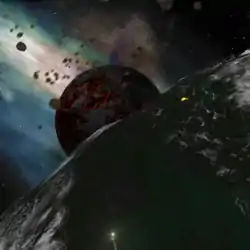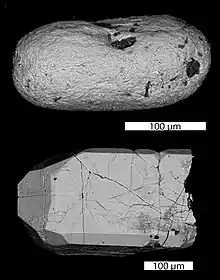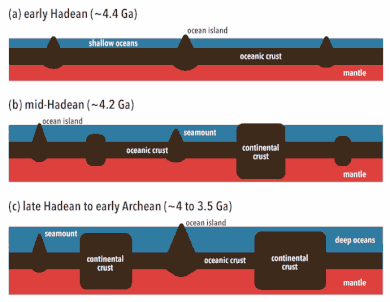Hadean
The Hadean (IPA: /heɪˈdiːən, ˈheɪdiən/ hay-DEE-ən, HAY-dee-ən) is the first and oldest of the four known geologic eons of Earth's history. It started with the planet's formation about 4.54 Bya,[2][3] now defined as (4567.30 ± 0.16) Mya[1] set by the age of the oldest solid material in the Solar System found in some meteorites about 4.567 billion years old.[4] The proposed interplanetary collision that created the Moon occurred early in this eon, and the Late Heavy Bombardment is hypothesized to have occurred at the end of the eon. The Hadean ended 4 billion years ago, as defined by the International Commission on Stratigraphy (ICS),[5] and was succeeded by the Archean eon.
| Hadean | ||||||
|---|---|---|---|---|---|---|
 Artist depiction of the hypothetical planet Theia colliding into Early Earth | ||||||
 Artist illustration of Earth and the Moon towards the middle/end of the Hadean eon | ||||||
| Chronology | ||||||
| ||||||
| Etymology | ||||||
| Synonym(s) | Priscoan Period Harland et al., 1989 | |||||
| Usage information | ||||||
| Celestial body | Earth | |||||
| Regional usage | Global (ICS) | |||||
| Definition | ||||||
| Chronological unit | Eon | |||||
| Stratigraphic unit | Eonothem | |||||
| First proposed by | Preston Cloud, 1972 | |||||
| Time span formality | Formal | |||||
| Lower boundary definition | (4567.30 ± 0.16) Ma[1] | |||||
| Lower GSSA ratified | October 5th, 2022[1] | |||||
| Upper boundary definition | 4000 Ma (defined chronometrically) | |||||
| Upper GSSA ratified | ||||||
Hadean rocks are very rare, largely consisting of granular zircons from one locality (Jack Hills) in Western Australia.[6] Hadean geophysical models remain controversial among geologists: it appears that plate tectonics and the growth of continents may have started in the Hadean.[6] Earth in the early Hadean had a very thick carbon dioxide- and methane-rich atmosphere, but eventually oceans made of liquid water formed.
Etymology
"Hadean" (from Hades, the Greek god of the underworld, and the underworld itself) describes the hellish conditions then prevailing on Earth: the planet had just formed and was still very hot owing to its recent accretion, the abundance of short-lived radioactive elements, and frequent collisions with other Solar System bodies.
The term was coined by American geologist Preston Cloud, after the Greek mythical underworld Hades, originally to label the period before the earliest-known rocks on Earth.[7][8] W. Brian Harland later coined an almost synonymous term, the Priscoan Period, from priscus, the Latin word for 'ancient'.[9] Other, older texts refer to the eon as the Pre-Archean.[10][11]
Rock dating
In the last decades of the 20th century, geologists identified a few Hadean rocks from western Greenland, northwestern Canada, and Western Australia. In 2015, traces of carbon minerals interpreted as "remains of biotic life" were found in 4.1-billion-year-old rocks in Western Australia.[12][13]

The oldest dated zircon crystals, enclosed in a metamorphosed sandstone conglomerate in the Jack Hills of the Narryer Gneiss Terrane of Western Australia, date to 4.404 ± 0.008 Ga.[14] This zircon is a slight outlier, with the oldest consistently-dated zircon falling closer to 4.35 Ga[14]—around 200 million years after the hypothesized time of Earth's formation.
In many other areas, xenocryst (or relict) Hadean zircons enclosed in older rocks indicate that younger rocks have formed on older terranes and have incorporated some of the older material. One example occurs in the Guiana shield from the Iwokrama Formation of southern Guyana where zircon cores have been dated at 4.22 Ga.[15]
Atmosphere
A sizable quantity of water would have been in the material that formed Earth.[16] Water molecules would have escaped Earth's gravity more easily when the planet was less massive during its formation. Photodissociation by short-wave ultraviolet in sunlight could split surface water molecules into oxygen and hydrogen, the former of which would be readily removed by the then-reducing atmosphere, while the latter (along with the similarly light helium) would be expected to continually escape (even to the present day) due to atmospheric escape.
Part of the ancient planet is theorized to have been disrupted by the impact that created the Moon, which should have caused the melting of one or two large regions of Earth. Earth's present composition suggests that there was not complete remelting as it is difficult to completely melt and mix huge rock masses.[17] However, a fair fraction of material should have been vaporized by this impact. The material would have condensed within 2,000 years,[18] leaving behind hot volatiles which probably resulted in a heavy CO
2 atmosphere with hydrogen and water vapor. The initial heavy atmosphere had a surface temperature of 230 °C (446 °F) and an atmospheric pressure of above 27 standard atmospheres.[18]
Oceans
Studies of zircons have found that liquid water may have existed between 4.0 and 4.4 billion years ago, very soon after the formation of Earth.[14][19] Liquid water oceans existed despite the high surface temperature, because at an atmospheric pressure of 27 atmospheres, water remains liquid even at those high temperatures.[18]
Asteroid impacts during the Hadean and into the Archean would have periodically disrupted the ocean. The geological record from 3.2 Gya contains evidence of multiple impacts of objects up to 100 kilometres (62 mi) in diameter.[20] Each such impact would have boiled off up to 100 metres (330 ft) of a global ocean, and temporarily raised the atmospheric temperature to 500 °C (932 °F).[20] However, the frequency of meteorite impacts is still under study: the Earth may have gone through long periods when liquid oceans and life were possible.[19]
The liquid water would absorb the carbon dioxide in the early atmosphere, not enough by itself to substantially reduce the amount of CO
2.[18]
Plate tectonics

A 2008 study of zircons found that Australian Hadean rock contains minerals pointing to the existence of plate tectonics as early as 4 billion years ago (approximately 600 million years after Earth's formation).[21] However, some geologists suggest that the zircons could have been formed by meteorite impacts.[22] The direct evidence of Hadean geology from zircons is limited, because the zircons are largely gathered in one locality in Australia.[6][23] Geophysical models are underconstrained, but can paint a general picture of the state of Earth in the Hadean.[6][24]
Mantle convection in the Hadean was likely vigorous, due to lower viscosity.[6] The lower viscosity was due to the high levels of radiogenic heat and the fact that water in the mantle had not yet fully outgassed.[25] Whether the vigorous convection led to plate tectonics in the Hadean or was confined under a rigid lid is still a matter of debate.[6][23][26][27] The presence of Hadean oceans are thought to trigger plate tectonics.[28]
Subduction due to plate tectonics would have removed carbonate from the early oceans, contributing to the removal of the CO
2-rich early atmosphere. Removal of this early atmosphere is evidence of Hadean plate tectonics.[29]
If plate tectonics occurred in the Hadean, it would have formed continental crust.[30] Different models predict different amounts of continental crust during the Hadean. The work of Dhiume et al. predicts that by the end of the Hadean, the continental crust had only 25% of today's area.[31] The models of Korenaga, et al. predict that the continental crust grew to present-day volume sometime between 4.2 and 4.0 Gya.[30][32]
Continents
The amount of exposed land in the Hadean is only loosely dependent on the amount of continental crust: it also depends on the ocean level.[6] In models where plate tectonics started in the Archean, Earth has a global ocean in the Hadean.[33][34] The high heat of the mantle may have made it difficult to support high elevations in the Hadean.[35][36] If continents did form in the Hadean, their growth competed with outgassing of water from the mantle.[6] Continents may have appeared in the mid-Hadean, and then disappeared under a thick ocean by the end of the Hadean.[37] The limited amount of land has implications for the origin of life.[6]
See also
- Chaotian (geology) – Proposed era of the Hadean eon
- Faint young Sun paradox – Paradox concerning water on early Earth
- Formation and evolution of the Solar System
- Hadean zircon – Oldest-surviving crustal material from the Earth's earliest geological time period
- History of Earth – Development of planet Earth from its formation to the present day – the first sections describe the formation of Earth
- Oldest dated rocks – Includes rocks over 4 billion years old from the Hadean Eon
- Precambrian – History of Earth 4600–539 million years ago
- Timeline of natural history
References
- Cohen, Kim (October 2022). "New edition of the Chart - 2022-10". International Commission on Stratigraphy. Retrieved 16 January 2023.
2022/10 - Hadean: GSSA instated as ratified by IUGS (5-10-2022). The GSSA is 4,567.30 ± 0.16 Ma.
- Dalrymple, G. Brent (2001). "The age of the Earth in the twentieth century: a problem (mostly) solved". Geological Society, London, Special Publications. 190 (1): 205–221. Bibcode:2001GSLSP.190..205D. doi:10.1144/gsl.sp.2001.190.01.14. S2CID 130092094. Retrieved 2022-10-02.
- "Age of the Earth". U.S. Geological Survey. 1997. Archived from the original on 23 December 2005. Retrieved 2022-10-03.
- Strachan, R.; Murphy, J.B.; Darling, J.; Storey, C.; Shields, G. (2020). "Precambrian (4.56–1 Ga)". In Gradstein, F.M.; Ogg, J.G.; Schmitz, M.D.; Ogg, G.M. (eds.). Geologic Time Scale 2020. Amsterdam: Elsevier. pp. 482–483. doi:10.1016/B978-0-12-824360-2.00016-4. ISBN 978-0-12-824360-2. S2CID 229513433.
- "International Chronostratigraphic Chart". International Commission on Stratigraphy. October 2022.
- Korenaga, J (2021). "Was There Land on the Early Earth?". Life. 11 (11): 1142. Bibcode:2021Life...11.1142K. doi:10.3390/life11111142. PMC 8623345. PMID 34833018.
- Cloud, Preston (1972). "A working model of the primitive Earth". American Journal of Science. 272 (6): 537–548. Bibcode:1972AmJS..272..537C. doi:10.2475/ajs.272.6.537.
- Bleeker, W. (2004). "10. Toward a "natural" Precambrian time scale". In Gradstein, Felix M.; Ogg, James G.; Smith, Alan G. (eds.). A Geologic Time Scale 2004. Cambridge, England, UK: Cambridge University Press. p. 145. ISBN 9780521786737.
- Oxford Dictionary, "Priscoan"
- Shaw, D.M. (1975). Early History of the Earth. Proceedings of the NATO Advanced Study Institute. Leicester: John Wiley. pp. 33–53. ISBN 0-471-01488-5.
- Jarvis, Gary T.; Campbell, Ian H. (December 1983). "Archean komatiites and geotherms: Solution to an apparent contradiction". Geophysical Research Letters. 10 (12): 1133–1136. Bibcode:1983GeoRL..10.1133J. doi:10.1029/GL010i012p01133.
- Borenstein, Seth (19 October 2015). "Hints of life on what was thought to be desolate early Earth". Excite. Yonkers, NY: Mindspark Interactive Network. Associated Press. Retrieved 2015-10-20.
- Bell, Elizabeth A.; Boehnike, Patrick; Harrison, T. Mark; et al. (19 October 2015). "Potentially biogenic carbon preserved in a 4.1 billion-year-old zircon". Proc. Natl. Acad. Sci. U.S.A. Washington, D.C.: National Academy of Sciences. 112 (47): 14518–21. Bibcode:2015PNAS..11214518B. doi:10.1073/pnas.1517557112. ISSN 1091-6490. PMC 4664351. PMID 26483481.
- Wilde, Simon A.; Valley, John W.; Peck, William H.; Graham, Colin M. (2001). "Evidence from detrital zircons for the existence of continental crust and oceans on the Earth 4.4 Gyr ago". Nature. 409 (6817): 175–178. Bibcode:2001Natur.409..175W. doi:10.1038/35051550. PMID 11196637. S2CID 4319774.
- Nadeau, Serge; Chen, Wei; Reece, Jimmy; Lachhman, Deokumar; Ault, Randy; Faraco, Maria; Fraga, Leda; Reis, Nelson; Betiollo, Leandro (2013-12-01). "Guyana: the Lost Hadean crust of South America?". Brazilian Journal of Geology. 43 (4): 601–606. doi:10.5327/Z2317-48892013000400002.
- Drake, Michael J. (April 2005). "Origin of water in the terrestrial planets". Meteoritics & Planetary Science. 40 (4): 519–527. Bibcode:2005M&PS...40..515J. doi:10.1111/j.1945-5100.2005.tb00960.x.
- Taylor, G. Jeffrey. "Origin of the Earth and Moon". Solar System Exploration. NASA. Archived from the original on March 8, 2015.
- Sleep, NH; Zahnle, K; Neuhoff, PS (2001). "Initiation of clement surface conditions on the earliest Earth". PNAS. 98 (7): 3666–3672. Bibcode:2001PNAS...98.3666S. doi:10.1073/pnas.071045698. PMC 31109. PMID 11259665.
- Valley, John W.; Peck, William H.; King, Elizabeth M.; Wilde, Simon A. (April 2002). "A Cool Early Earth". Geology. 30 (4): 351–354. Bibcode:2002Geo....30..351V. doi:10.1130/0091-7613(2002)030<0351:ACEE>2.0.CO;2. PMID 16196254. Archived from the original on 2013-06-16. Retrieved 2006-08-22.
- Lowe, DR; Byerly, GR (2015). "Geologic record of partial ocean evaporation triggered by giant asteroid impacts, 3.29–3.23 billion years ago". Geology. 43 (6): 535–538. Bibcode:2015Geo....43..535L. doi:10.1130/G36665.1.
- Chang, Kenneth (December 2, 2008). "A New Picture of the Early Earth". The New York Times.
- Kenny, GG; Whitehouse, MJ; Kamber, BS; et al. (April 12, 2016). "Differentiated impact melt sheets may be a potential source of Hadean detrital zircon". Retrieved March 6, 2017.
- Harrison, T. Mark (2020). Hadean Earth. Cham, Switzerland: Springer. Bibcode:2020hade.book.....H. doi:10.1007/978-3-030-46687-9. ISBN 978-3-030-46686-2. S2CID 128932829.
- Korenaga, J; Planavsky, NJ; Evans, DAD (2017). "Global water cycle and the coevolution of Earth's interior and surface environment". Phil. Trans. R. Soc. A. 375 (2094): 20150393. Bibcode:2017RSPTA.37550393K. doi:10.1098/rsta.2015.0393. PMC 5394256. PMID 28416728. S2CID 2958757.
- Korenaga, J (2021). "Hadean geodynamics and the nature of early continental crust". Precambrian Res. 359: 106178. Bibcode:2021PreR..359j6178K. doi:10.1016/j.precamres.2021.106178. S2CID 233441822.
- Tang, M; Chen, K; Rudnick, RL (2016). "Archean upper crust transition from mafic to felsic marks the onset of plate tectonics". Science. 351 (6271): 372–375. Bibcode:2016Sci...351..372T. doi:10.1126/science.aad5513. PMID 26798012. S2CID 206643793.
- Windley, BF; Kusky, T; Polat, A (2021). "Onset of plate tectonics by the Eoarchean". Precambrian Res. 352: 105980. Bibcode:2021PreR..352j5980W. doi:10.1016/j.precamres.2020.105980. S2CID 228993361.
- Regenauer-Lieb, K; Yuen, DA; Branlund, J (2001). "The initiation of subduction: Criticality by addition of water?". Science. 294 (5542): 578–580. Bibcode:2001Sci...294..578R. doi:10.1126/science.1063891. PMID 11641494. S2CID 43547982.
- Sleep, NH; Zahnle, KJ; Lupu, RE (2014). "Terrestrial aftermath of the Moon-forming impact". Phil. Trans. R. Soc. A. 372 (2024): 20130172. Bibcode:2014RSPTA.37230172S. doi:10.1098/rsta.2013.0172. PMID 25114303. S2CID 6902632.
- Guo, M; Korenaga, J (2020). "Argon constraints on the early growth of felsic continental crust". Science Advances. 6 (21): eaaz6234. Bibcode:2020SciA....6.6234G. doi:10.1126/sciadv.aaz6234. PMC 7314546. PMID 32671213.
- Dhuime, B; Hawkesworth, CJ; Cawood, PA; Storey, CD (2012). "A change in the geodynamics of continental growth 3 billion years ago". Science. 335 (6074): 1334–1336. Bibcode:2012Sci...335.1334D. doi:10.1126/science.1216066. PMID 22422979. S2CID 206538532.
- Rosas, JC; Korenaga, J (2018). "Rapid crustal growth and efficient crustal recycling in the early Earth: Implications for Hadean andArchean geodynamics". Earth Planet. Sci. Lett. 494: 42–49. Bibcode:2018E&PSL.494...42R. doi:10.1016/j.epsl.2018.04.051. S2CID 13666395.
- Russell, MJ (2021). "The "Water Problem", the illusory pond and life's submarine emergence—A review". Life. 11 (5): 429. doi:10.3390/life11050429. PMC 8151828. PMID 34068713.
- Voosen, P (2021). "Ancient Earth was a water world". Science. 371 (6534): 1088–1089. Bibcode:2021Sci...371.1088V. doi:10.1126/science.371.6534.1088. PMID 33707245. S2CID 232206926.
- Monteux, J; Andrault, D; Guitreau, M; Samuel, H; Demouchy, S (2020). "A mushy Earth's mantle for more than 500 Myr after the magma ocean solidification". Geophys. J. Int. 221 (2): 1165–1181. doi:10.1093/gji/ggaa064.
- Rey, PF; Coltice, N (2008). "Neoarchean lithospheric strengthening and the coupling of Earth's geochemical reservoirs". Geology. 36 (8): 635–638. Bibcode:2008Geo....36..635R. doi:10.1130/G25031A.1;.
{{cite journal}}: CS1 maint: ignored DOI errors (link) - Bada, JL; Korenaga, J (2018). "Exposed areas above sea level on Earth >3.5 Gyr ago: Implications for prebiotic and primitive biotic chemistry". Life. 8 (4): 55. Bibcode:2018Life....8...55B. doi:10.3390/life8040055. PMC 6316429. PMID 30400350.
Further reading
- Hopkins, Michelle; Harrison, T. Mark; Manning, Craig E. (2008). "Low heat flow inferred from >4 Gyr zircons suggests Hadean plate boundary interactions". Nature. 456 (7221): 493–496. Bibcode:2008Natur.456..493H. doi:10.1038/nature07465. PMID 19037314. S2CID 4417456.
- Wyche, S.; Nelson, D. R.; Riganti, A. (2004). "4350–3130 Ma detrital zircons in the Southern Cross Granite–Greenstone Terrane, Western Australia: implications for the early evolution of the Yilgarn Craton". Australian Journal of Earth Sciences. 51 (1): 31–45. Bibcode:2004AuJES..51...31W. doi:10.1046/j.1400-0952.2003.01042.x.
- Carley, Tamara L.; et al. (2014). "Iceland is not a magmatic analog for the Hadean: Evidence from the zircon record". Earth and Planetary Science Letters. 405 (1): 85–97. Bibcode:2014E&PSL.405...85C. doi:10.1016/j.epsl.2014.08.015.
- Marchi, S.; et al. (2014). "Widespread mixing and burial of Earth's Hadean crust by asteroid impacts". Nature. 511 (7511): 578–582. Bibcode:2014Natur.511..578M. doi:10.1038/nature13539. PMID 25079556. S2CID 205239647.